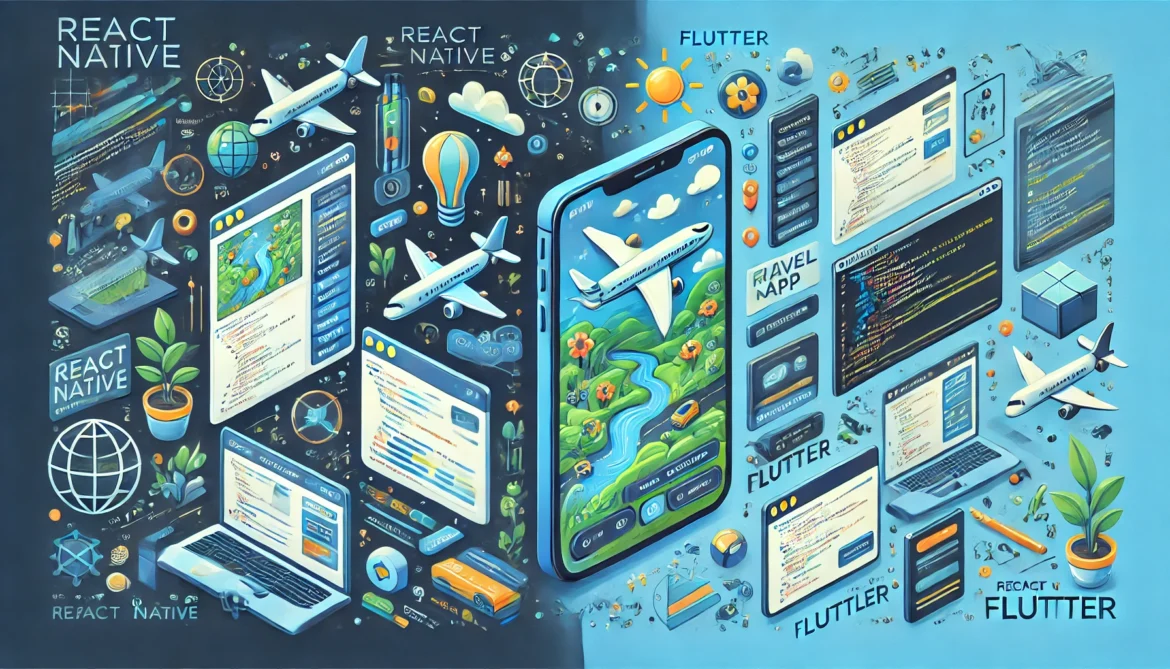Table of Contents
React Native vs Flutter: Which One is Better for Travel Apps?
Picking the right tool to build your travel app can be tricky. React Native and Flutter are two popular choices, but which one is best? Let’s dive in and compare these two app-making powerhouses to see which fits your travel app needs better.
Introduction to React Native and Flutter
React Native: The Trailblazer
React Native, developed by Facebook, has been a game-changer in the world of cross-platform app development since its inception in 2015. It allows developers to build mobile applications using JavaScript and React, leveraging a single codebase for both iOS and Android platforms. React Native’s “learn once, write anywhere” philosophy has made it a favorite among developers, especially those already familiar with web development.
Flutter: The Rising Star
Flutter, Google’s UI toolkit, entered the scene in 2017 and quickly gained traction. It uses Dart as its programming language and offers a rich set of pre-designed widgets for creating visually appealing, natively compiled applications. Flutter aims to streamline the development process and provide a consistent user experience across platforms.
Key Differences and Similarities
While both frameworks enable cross-platform development, they are different in their underlying architecture and rendering methods. React Native uses a bridge to communicate with native components, while Flutter draws its own UI components using Skia, a 2D graphics engine. This fundamental difference affects performance, UI customization, and the overall development experience.
Despite their differences, React Native and Flutter share common goals: to simplify travel app development, reduce time to market, and enable developers to create beautiful, responsive applications. As we examine their advantages and disadvantages, we’ll see how these frameworks stack up for travel app development, with a particular focus on why React Native might be the preferred choice for many projects in this domain.
Comparing Performance and Speed
When it comes to travel app development, performance and speed are crucial factors that can make or break user experience. Both React Native and Flutter offer impressive capabilities in this arena, but let’s dive deeper into how they stack up against each other.
Rendering Speed
React Native generally offers faster initial rendering times compared to Flutter. This is particularly beneficial for travel apps that need to display complex itineraries or large amounts of data quickly. React Native’s use of native components contributes to this speed advantage, ensuring a smooth user experience from the moment the app launches.
Memory Usage
Flutter tends to consume more memory than React Native, which can be a concern for resource-intensive travel applications. React Native’s leaner memory footprint makes it a preferable choice for apps that need to run efficiently on a wide range of devices, including older smartphones that travelers might still be using.
App Size
Travel apps often need to be lightweight, especially for users who may be downloading them while on the go. React Native typically produces smaller app sizes compared to Flutter. This can be a significant advantage for travel apps, as users are more likely to download and keep a compact app on their devices, particularly when storage space is at a premium during trips.
Hot Reload Functionality
Both frameworks offer hot reload capabilities, but React Native’s implementation is often considered more stable and reliable. This feature allows developers to make real-time changes to the app’s UI and logic, significantly speeding up the development process for travel apps that require frequent updates and refinements based on user feedback or changing travel trends.
Ease of Development with React Native vs Flutter
Learning Curve and Development Speed
React Native offers a gentler learning curve for developers already familiar with JavaScript and React. This familiarity allows teams to quickly adapt and start building travel apps with minimal additional training. Flutter, while powerful, requires learning Dart, a less common programming language. This initial hurdle can slow down development in the early stages.
Component Libraries and UI Development
React Native shines in its extensive ecosystem of pre-built components and third-party libraries. For travel apps, this means faster implementation of common features like maps, booking interfaces, and itinerary planners. Flutter’s widget system is comprehensive but may require more custom coding for travel-specific functionalities.
Cross-Platform Consistency
While both frameworks aim for cross-platform development, React Native’s “learn once, write anywhere” philosophy often translates to smoother deployment across iOS and Android. This consistency is important for travel apps, where users expect a seamless experience regardless of their device. Flutter, though improving, sometimes requires platform-specific adjustments to achieve the same level of consistency.
Performance Optimization
React Native leverages native components, resulting in apps that feel more native and perform well on various devices. This is particularly important for travel apps that may need to function in areas with limited connectivity. Flutter’s performance is impressive but may require more fine-tuning to match React Native’s efficiency in complex travel app scenarios.
Developer Community and Ecosystem
React Native’s Thriving Community
React Native has a big and active developer community, which is a significant advantage for travel app development. This extensive network provides invaluable support, resources, and third-party libraries that can streamline the development process. With a wealth of documentation, tutorials, and forums available, developers can quickly find solutions to common challenges, reducing development time and costs.
Flutter’s Growing Presence
While Flutter’s community is rapidly expanding, it’s still catching up to React Native’s established ecosystem. However, Flutter’s increasing popularity among developers is driving the creation of new packages and tools, making it a strong contender in the mobile app development space.
In terms of long-term support and stability, React Native’s backing by Facebook provides reassurance for developers and businesses alike. This corporate support ensures continued development and maintenance of the framework, making it a reliable choice for travel app projects with extended timelines.
Case Studies: Top Travel Apps Built With React Native
React Native has become a popular choice for developing travel apps, with several industry leaders leveraging its capabilities. As travel brands prioritize mobile app engagement to enhance UX and customer loyalty, React Native offers a compelling solution. Let’s explore some examples that showcase the framework’s strengths.
Airbnb
Airbnb, a global leader in the travel and hospitality industry, was an early adopter of React Native. The company initially used the framework to build parts of its mobile app, citing faster development cycles and improved cross-platform consistency as main benefits. While Airbnb has since transitioned away from React Native, their experience highlighted the framework’s potential for prototyping and iteration in the travel sector.
Skyscanner
Skyscanner, a popular flight search engine, successfully implemented React Native in their mobile app. The framework helped them to maintain a consistent user interface across platforms while optimizing performance. Skyscanner reported significant improvements in app load times and overall user engagement after adopting React Native.
Uber Eats
Although not exactly a travel app, Uber Eats demonstrates React Native’s versatility in location-based services. The food delivery platform uses React Native for its restaurant dashboard, showcasing the framework’s ability to handle real-time data and complex user interfaces. This example illustrates React Native’s potential for travel apps that require similar functionalities, such as real-time booking systems or interactive maps.
TripAdvisor
TripAdvisor, one of the world’s largest travel platforms, has incorporated React Native into its mobile app development process. By using React Native, TripAdvisor was able to streamline its development workflow and maintain feature parity across iOS and Android platforms more efficiently. This underscores React Native’s value for large-scale travel applications with diverse functionalities.
These examples demonstrate React Native’s capacity to deliver high-quality, performant travel apps across various use cases. From accommodation booking to flight searches and location-based services, React Native has proven its versatility and efficiency in the travel industry.
Conclusion
Out of all the options of developing a travel app, React Native comes to the front. This is due to its mature ecosystem, extensive third-party libraries, and flawless integrations with native components.
Ultimately, it all comes down to what your exact needs are for the project and who is available within your team. With React Native, you’re all in on the tested framework that never stops developing and helps keep your travel app competitive, adaptive, and relevant in the rapidly evolving mobile space.









